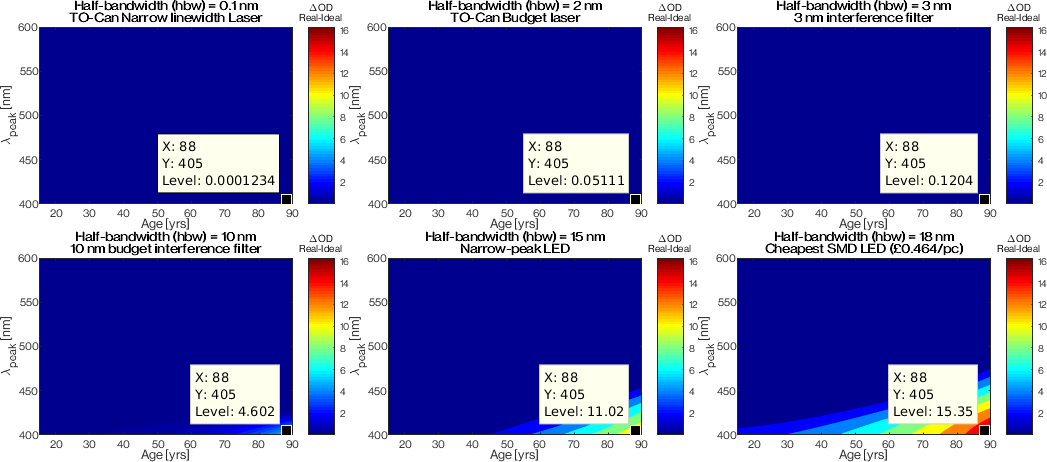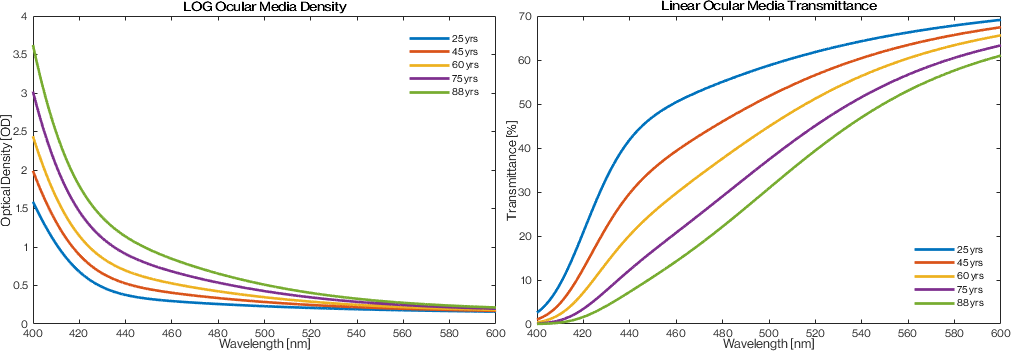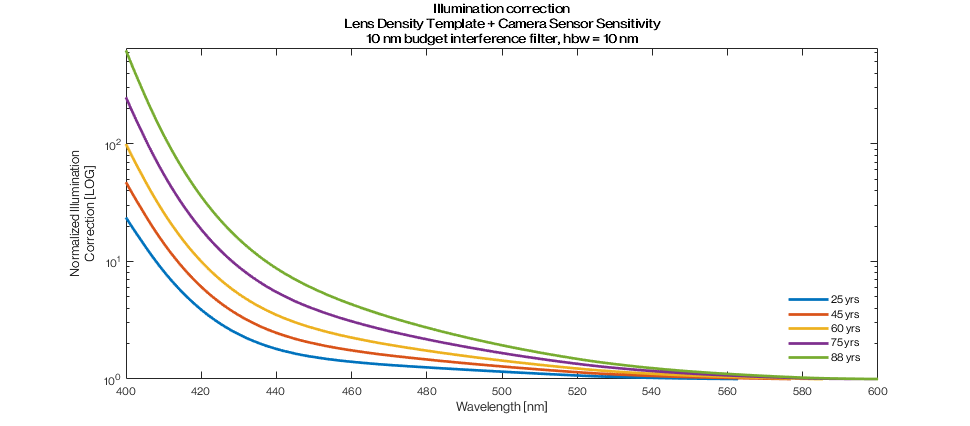Some extra simulations for the paper "A Purkinje image-based system for an assessment of the density and transmittance spectra of the human crystalline lens in vivo" Taisuke Eto, Petteri Teikari, Raymond P Najjar, Yuki Nishimura, Yuki Motomura, Manami Kuze, Shigekazu Higuchi Scientific Reports volume 10, Article number: 16445 (2020) https://doi.org/10.1038/s41598-020-73541-y
Quick'n'dirty approximation of the error in spectral ocular media density estimation using Purkinje images as a function of the (virtual) age (as specified by the van de Kraats and van Norren 2007 ocular media model, see lensMediaWrapper.m and lensModel_vanDeKraats2007.m for code), half-bandwidth (hbw) and peak wavelength (lambda_peak) of the used light source(s).
extreme example of the over-estimation of ocular media density at age = 88 years, and at lambda_peak = 405 nm with 6 different half-bandwidths of real commercial light emitters / interference filters. You can see that when using hbw = 3 nm interference filters, the error is quite negligible, whereas unfiltered "broadband" LED starts to introduces quite massive error. Positive deltaOD means that real-life SPD (spectral power distribution) overestimates ocular media density over "ideal SPD" with all the energy on single wavelength.
The "TO-Can Narrow linewidth Laser" should be quite close to the "ideal SPD" source, and the code needs some re-checking, as there is some "spectral round-off" error probably happening at light source generation part monochromaticLightAsGaussian.m, the "ideal source" is not generated from the same code.
See the light sources in lightSource_wrapper.m:
hbw= 8.7500e-05 nm : TO-Can Narrow linewidth Laser - e.g. Ondax 405 nm CP-405-PLR12hbw= 2 nm : TO-Can Budget laser - e.g. Sony OPTLD004, Wavespectrum WSLD-405-150m-1hbw= 3 nm : 3 nm interference filter - e.g. Knight Optical 405 nm 405FIN2, BFI Optilashbw= 10 nm : 10 nm budget interference filter - e.g. EO 405 nm #65-618, or UV LED without filter, e.g. Luminus SST-10-UVhbw= 15 nm : Narrow-peak LED - e.g. Kingbright 405 nm ATDS3534UV405Bhbw= 18 nm : Cheapest SMD LED (£0.464/pc) - % e.g. Vishay VLMU3100-GS08
Run densityModel_sensitivityAnalysis_v2020.m
Run density_error_plot.m, and Matlab will import the pre-computed values from plot_debug.mat
Run plot_lens_density.m that will give you this:
You see that if you are interested in designing your measurement system that you want to cover the short wavelength range with smaller wavelength increments as most of the density changes happen there, and in general your measurement comes noisier there. You can just throw couple of wavelengths above ~530 nm to constrain your model fit? The offset parameter in the lensModel_vanDeKraats2007.m defines the spectrally neutral "global optical density", and default value of 0.111 was used for this in lensMediaWrapper.m
Run plot_compensated_lights.m which will approximate how much you should boost short wavelengths even to detect the 4th Purkinje image on shorter wavelengths (See "Illumination compensation " in Wiki for rationale behind this plot)
The 60 year old template lens should have as large as 2 log unit compensation if you would be using 400 nm peak wavelengths by simple transmittance attenuation analysis
- Purkinje imaging for crystalline lens density measurement (2018), https://www.slideshare.net/PetteriTeikariPhD/purkinje-imaging-for-crystalline-lens-density-measurement
- Multispectral Purkinje Imaging (2018), https://www.slideshare.net/PetteriTeikariPhD/multispectral-purkinje-imaging
- Novel system for measuring the scattering of the cornea and the lens (2018) by Pau Santos Vives (PhD thesis from UPC, Barcelona), https://upcommons.upc.edu/handle/2117/121192
- System based on the contrast of Purkinje images to measure corneal and lens scattering by Pau Santos (2018), https://doi.org/10.1364/BOE.9.004907
- Optical quality of the eye lens surfaces from roughness and diffusion measurements (1986) by Rafael Navarro et al. https://doi.org/10.1364/JOSAA.3.000228
See the Wiki for more details, and some background ophthalmic optics theory.



